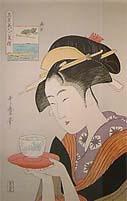

 |
Intermediate
Moto style sake recipe
|
|
Overview
This recipe will produce a sake with a naturally grown lactic acid base that is generally associated with the lovingly made, very expensive boutique sakes found only in Japan.
It is essential that the reader is familiar with the Basic Sake recipe and is familiar with making malt-rice (Kome Koji). The intermediate sake recipe firstly creates a starter culture (Moto) that will create a rich lactic acid and yeast slurry that will start your brew with the desired micro-organisms. All your malt rice (Kome Koji) can be made in one session and stored in the freezer and used as required.
The Moto is created at a temperature of 5-10°centigrade(40°-50° F), at these temperatures lactic acid organisms becomes dominant and provide a very suitable medium to establish a thriving yeast culture. Lactic acid is very important to provide the right flavor and prevent unwanted infections. It is wise to use a yeast that works well in lower temperatures such as lager yeast.
Step One: Create your Moto starter culture.
Step Two: Mix your starter culture with more rice and malt-rice (Kome-Koji) to create a brew with the right micro-organisms.
Instructions for Intermediate recipe (producing 3 liters)
Step one: Making Moto
Materials:
187.5 grams Steamed Rice
75 grams Koji Rice
270ml Water (chilled, soft, chlorine and iron free)
5 grams suitable low temperature yeast i.e. lager yeast. As starch is converted to sugar then alcohol in one instantaneous process, unusually high alcohol levels (18% alc/vol) can be created from low alcohol yeasts.
Procedure:
Combine all ingredients and keep in the fridge for 10 days at a temperature of 5-10°centigrade(40°-50° F), stir the mixture a couple of times a day. The texture will change gradually from swollen rice grains to a porridge texture as the days go by and will eventually become a creamy soup texture. The yeast becomes active after 3 days and the surface will appear to bubble.
The taste also changes from sweet to slightly acidic and finally acidic and bitter. By this stage 10 days should have elapsed and now the moto is ready do it's work.
A
Modern Moto Method (very easy temperature management compared to the
traditional)
A moto can be made by mixing
185 gms of rice with 185 gms of koji and 185 mls of water at 60° (140°F).
To this mix add one teaspoon (5gm)of natural yoghurt. This is a source of lactic
acid. Allow to cool to 40°c(106°F) and maintain for 24hrs. At this stage
the moto should be bubbling slowly, slightly sweet and acidic with the texture
of porridge. There should be a strong cheesy sour smell. Now, cool to 25°C
and add 5 gms of yeast. This is normal room temperature and makes the next stage
very easy. After 6 hours the smell will go. Maintain at 25°C (106°F)
and day 3 will produce a moto that is bitter and acidic with heavy yeast bubbling
activity. By the end of day 4 the moto will be ready and can be used as described
in the intermediate and advanced recipe.
Step Two: Brewing Sake with Moto
Materials:
2250 grams Steamed rice
710 grams Koji rice
3870 ml chilled water
Moto (as described above)
Procedure:
combine all of the below materials in a suitable brewing container, stirring everyday for 20 days keeping the fermenting container at about 10°-15° centigrade(50°-60° F).
After 10 hours all the water will be absorbed and you will have a swollen rice grain texture.
After 2 days the mix will become like soup.
Day 3 the yeast will be active with visible bubbling and the texture becomes increasingly fluid..
Day 8 the texture is now fluid with a new complex bitter flavor in the taste.
Day 10 alc/vol is now approx10%.
Day 12 alc/vol is now approx13%
Day 17 alc/vol is now approx 16%
Day 20 the brew is ready to be strained through cheese cloth or nylon straining bag and pasteurized and bottled.
Brewing containers and bottles should be sterilized by washing with Sodium Metabisulphate. Please use caution when using this product and be sure to read the manufacturers instructions carefully. Household bleach can also be used for sterilizing, again follow manufactures instructions.
Pasteurizing: Sake that is stored with yeasts still alive in the bottle may be unstable and not preserve well. Sake can be stabilized by pasteurizing, this process requires GENTLY heating the strained brew in a saucepan for 5 mins at 55 degrees centigrade(132° F), this will slightly change the character of the drink. Allow the sake to cool before bottling. This bottle will be now good for many years while it remains unopened. Generally sake will improve for the first few months after bottling. Leave it for at least a week after pasteurizing before drinking. Any sterile sealed bottle will work well for storing Sake. Store in a dark place as light does not agree with Sake. One can choose not to pasteurize, however be sure to keep the Sake refrigerated at all times to preserve it well.
An extremely pleasant tasting drink, approximately 14% to 18% alc/vol, can be produced by following the above instructions. This particular style of Sake is best served chilled. Fish and cheese are very suitable Sake companions.
Copyright 2013 Vision Brewing. All rights reserved.